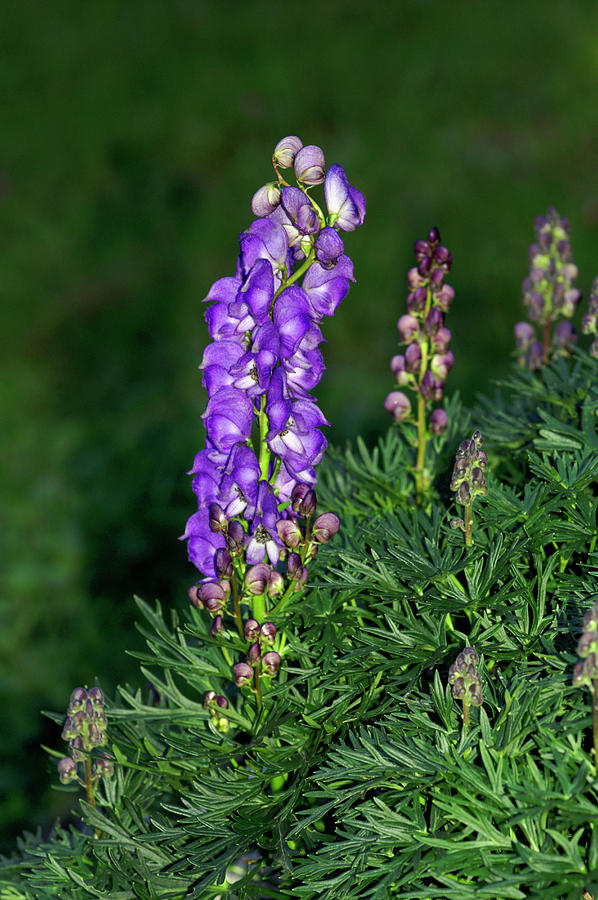

The clumps are easily divided in early spring.Īlthough plants can be grown from seed, this form of propagation is only for patient gardeners, as the seed is usually dormant and can take up to 100 days to germinate and three years to bloom. They are said to resent being dug, but I have never experienced this as a problem and they benefit from division every four years or so to renew the clumps. Fertilize them in spring with an organic fertilizer. Monkshoods are woodland plants and prefer rich, evenly moist soils in partial shade and a deep mulch. septentrionale ‘Ivorine’) has white flowers in midsummer and grows 60-90 cm (2-3 ft) in height. ‘Bressingham Spire’ is a compact plant of 60-90 cm (2-3 ft) in height with blue flowers in summer. ‘Spark’s Variety’ has dark purplish-blue flowers in dense terminal racemes about 120 cm (4 ft) tall in late summer. napellus) is native to Western and Central Europe and is about one metre (3 ft) tall with deep purplish blue flowers in midsummer. The Hermit is a card of spiritual knowledge and attainment. Wolfsbane or Monkshood is associated with the Hermit in Tarot.
#WOLFSBANE FLOWER POISON FULL#
‘Arendsii’, with deep blue flowers in fall, was developed by the German nurseryman George Arends.īlue monkshood ( A. Wolfsbane flower Essence is a vibrational flower Essence made under the full moon and can be used for introspection, inner wisdom, solitude, and spiritual pursuits. It is most noted as a heart poison but is also a potent nerve poison. Aconitine is the most dangerous of these toxins. All parts of the plant, especially the roots, contain toxins. fischeri)) blooms in fall on 120-150 cm (4-5 ft) stems with azure blue flowers. napellus, also known as monkshood or wolfsbane) is a perennial herb often grown as an ornamental plant due to its attractive blue to dark purple flowers. cammarum ‘Bicolor’) has white flowers with blue edges on 90-120 cm (3-4 ft) stems in mid-summer.Īzure monkshood ( Aconitum carmichaelii, syn. This advertisement has not loaded yet, but your article continues below. fischeri), produces azure flowers in autumn. Most cultivars of European origin bloom in mid- to late summer while the Asian species, A. Wolfsbane is one name for the genus Aconitum, a poisonous plant long used to kill predator animals in much of the world. The monkshood flowers are generally blue to azure, but some have flowers that are white or largely white with blue edges. Inhaling or ingesting wolfsbane in the real world could kill you.

Most of our garden varieties originated in Europe or Asia. There are various hardy species and varieties that are well suited to our northern gardens. They seldom require staking unless in an exposed, windy location or planted in deep shade and reaching for the sun. Deadheading spent flowers may result in the production of smaller blooms from secondary spikes.

Their spikes resemble delphiniums (to which they’re related) but are stiffer and sturdier. Yet despite its reputation as an agent of evil, monkshood makes an attractive contribution to our prairie perennial borders.ĭifferent species flower over a long period through the summer, but the most popular varieties bloom in late summer. Likewise, American species were used by Indigenous peoples to poison their arrow tips. The genus name, Aconitum, is derived from the Greek word “akoniton” meaning dart and refers to its past use to poison darts or arrow tips. Manage Print Subscription / Tax Receipt.Here are some of the most common plants that might be starting to pop up in your garden and nearby areas which can be toxic to your pet. Avoiding plants which may be toxic for your pets is the easiest way to stop them from eating them and becoming ill. Don’t take the risk! Let your vet use their expertise to give your pet the best chance of a healthy and fast recovery. Some poisons are fast acting, and even if you think you might have a home remedy, some plants can be easily confused for one another but may have a very different effect on your cat or dog. If your pet exhibits any of the above symptoms, take them to a vet immediately. Keep an eye out for the common signs of poisoning: While this is something to be encouraged, potato plant leaves are toxic to dogs, while tomato plant leaves and unripe tomatoes are poisonous to both dogs and cats. For instance, more Britons than ever are growing their own tomatoes and potatoes. The complete list of plants which can be toxic to pets is quite exhaustive ( here is one such list). Signs your pet has ingested something poisonous


 0 kommentar(er)
0 kommentar(er)
